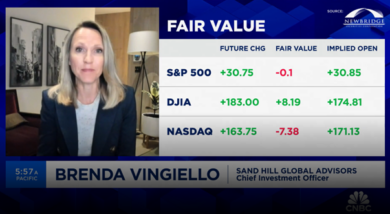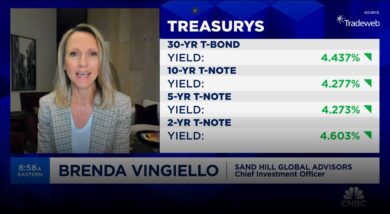Sand Hill's Chief Investment Officer, Brenda Vingiello, CFA, joins Jenny Harrington on “Halftime Report” to go over their most recent portfolio moves. Brenda's commentary begins

The Facts Ma’am, Just the Facts
As we reflect on the eventful year just passed, it is a good reminder of how difficult it can be to predict market outcomes. Even in the eighth year of a business cycle, and during a period when domestic policy struggles and geopolitical tensions were probably at their highest level in a decade, capital markets around the world still collectively posted their third highest returns since the severe financial crisis of 2008 as global growth expanded in a synchronized fashion. With markets now at all-time highs, volatility at historical lows, and economic data continuing to signal ongoing, above-average global growth, many market participants are surely wondering if financial markets might be a little too stretched and exuberant entering 2018; and, if so, does this leave little upside to be excited about going forward from here. After all, it seems like a recession should be “due” in the next year or two, given the length of this current economic cycle.
We spend a significant amount of time contemplating and debating these issues, and at present we don’t see a near-term end to this economic cycle, nor do we feel that 2018 will necessarily be characterized by below-average returns. Last year, double digit corporate earnings growth across all corners of the world was responsible for the majority of equity market returns, and our 2018 projections suggest another year of above-average growth. Nevertheless, even against this positive backdrop, many economic indicators bear close monitoring, and should there be deterioration in the data, we will likely reduce equity exposure and reallocate in favor of preserving capital. Additionally, valuations cannot be ignored, and should equity markets ultimately reach what we believe are unsustainable levels, this too would cause us to reduce exposure.
Historically, there has never been a single magic economic indicator that reliably and accurately signals pending recession. Instead, tracking a basket of various indicators creates the best chance of detecting softness that may eventually be felt more broadly. We track a large number of leading indicators, well beyond some of the more common ones that we highlight below, and currently, none of our favorite metrics are showing signs of softening. Here are some brief descriptions of the more useful indicators.
The Institute for Supply Management (ISM) Manufacturing and Non-Manufacturing survey is a monthly nationwide survey of purchasing and supply executives that is weighted based on each industry’s contribution to GDP. Executives are asked to comment on a number of measures including new orders, backlogs, production and inventories, to name a few. Results are then quantified, with an overall reading of 50, indicating “expansion” in a given industry. As of just last month (December 2017), the reading for manufacturing industries was very strong at 59.7; and for non-manufacturing, or services, it was equally impressive at almost 56. This suggests that our economy is continuing to broadly grow. Of course, if these surveys were to definitively peak and begin to clearly contract, we would consider this to be a meaningful change in trend and we would reduce risk in your portfolio.
Corporate credit spreads are another economic indicator that we closely watch. Credit spreads measure the difference between U.S. Treasury bond yields and the yields of typically riskier corporate bonds. When the difference (or spread) in yield is very small, it is considered to be a sign that market participants feel the creditworthiness of a bond issuer is not much different than that of the U.S. Treasury. When the yield differential begins to increase (or widen), this signals that bond buyers are concerned and demanding more yield in return for holding a bond they consider to be riskier than a Treasury bond. Historically, credit spreads have usually widened ahead of recessions as investors begin to question the ability of companies to service their debt, and at this point in the cycle we are not seeing any troubling signs of this phenomenon. Indeed, credit spreads remain near historic lows.
The health of the labor market is another important barometer. The vast majority of GDP in the U.S. is driven by consumer spending, and thus, any widespread and imminent fear of losing a job and becoming unemployed would be a big deterrent to spending beyond one’s very basic needs. With the exception of only a one month weather-related dip in September of last year (due to the destructive hurricanes), the employment market has continued to be very healthy. In fact, for the last seven years, the U.S. has created in excess of two million jobs per annum. This is only the second time in history that the economy has produced jobs at that pace for this long, which obviously begs the question of how sustainable such a continuation of job growth can be. In our view, a natural progression would be one where job growth softens modestly but wage growth increases. So, if the unemployment rate were to rise slightly, this would not necessarily be cause for concern; but if it were to rise above the 6% level, then we would certainly take notice.
Moreover, inflation and tight labor markets go hand-in-hand. If wages begin to rise significantly, the Federal Reserve would likely become more aggressive in their reaction by raising short-term interest rates more quickly than they have indicated, and this is not something that the market is currently anticipating. Additionally, if global economic growth continues, other central banks have indicated they will, in due course, mimic the Federal Reserve in their efforts to reduce the size of their balance sheets, too. These various factors would lead to a steepening of the yield curve, and if the 10-year Treasury yield were to rise above 3%, this would create a more compelling investment opportunity to hold bonds, and thus, we would rotate some additional assets into this asset class.
All of this involves constant monitoring and staying disciplined to an investment strategy, which continues to be a good practice when it comes to the always unknown future of stock market valuations. We are firm believers in reducing exposure to stocks when we feel that valuations become too lofty to justify, even if there are no signs of a potential recession on the horizon. During 2017, the majority of the stock market move was driven by very robust earnings growth. Projections for this year are calling for another year of solid, though perhaps more modest growth, which should result in a more normalized — but still positive – return environment, even if valuations decline a little bit. Should equity markets race on ahead too quickly and appreciate well beyond our projected earnings growth, we would reduce exposure since we do not feel that substantially higher valuations are justified at this stage.
As the ninth year of this economic cycle evolves, it will be increasingly difficult to ignore the longevity of this current expansion. However, the overall level of the expansion has nonetheless been subdued when compared to many other historical economic cycles. As a result, this could enable a continuation of growth longer than many expect, particularly as other economies around the world move firmly into the next stage of their own lagging economic recoveries. Looking beyond the popular metrics that we have highlighted above, other measures of leading indicators such as retail sales, new building permits, unemployment claims and small business optimism are also signaling a continuation of the strong trends we experienced in 2017. Still, the world is an uncertain place and any number of potential challenges may emerge – including trade wars or geopolitical unrest – that may rattle financial markets and adversely impact global growth. Ignoring emotions and resisting the temptation to make big, bold predictions, and instead focusing on maintaining a disciplined process and monitoring these types of economic data points, corporate earnings and valuation trends, is at the core of our decision-making process.
Articles and Commentary
Information provided in written articles are for informational purposes only and should not be considered investment advice. There is a risk of loss from investments in securities, including the risk of loss of principal. The information contained herein reflects Sand Hill Global Advisors' (“SHGA”) views as of the date of publication. Such views are subject to change at any time without notice due to changes in market or economic conditions and may not necessarily come to pass. SHGA does not provide tax or legal advice. To the extent that any material herein concerns tax or legal matters, such information is not intended to be solely relied upon nor used for the purpose of making tax and/or legal decisions without first seeking independent advice from a tax and/or legal professional. SHGA has obtained the information provided herein from various third party sources believed to be reliable but such information is not guaranteed. Certain links in this site connect to other websites maintained by third parties over whom SHGA has no control. SHGA makes no representations as to the accuracy or any other aspect of information contained in other Web Sites. Any forward looking statements or forecasts are based on assumptions and actual results are expected to vary from any such statements or forecasts. No reliance should be placed on any such statements or forecasts when making any investment decision. SHGA is not responsible for the consequences of any decisions or actions taken as a result of information provided in this presentation and does not warrant or guarantee the accuracy or completeness of this information. No part of this material may be (i) copied, photocopied, or duplicated in any form, by any means, or (ii) redistributed without the prior written consent of SHGA.
Video Presentations
All video presentations discuss certain investment products and/or securities and are being provided for informational purposes only, and should not be considered, and is not, investment, financial planning, tax or legal advice; nor is it a recommendation to buy or sell any securities. Investing in securities involves varying degrees of risk, and there can be no assurance that any specific investment will be profitable or suitable for a particular client’s financial situation or risk tolerance. Past performance is not a guarantee of future returns. Individual performance results will vary. The opinions expressed in the video reflect Sand Hill Global Advisor’s (“SHGA”) or Brenda Vingiello’s (as applicable) views as of the date of the video. Such views are subject to change at any point without notice. Any comments, opinions, or recommendations made by any host or other guest not affiliated with SHGA in this video do not necessarily reflect the views of SHGA, and non-SHGA persons appearing in this video do not fall under the supervisory purview of SHGA. You should not treat any opinion expressed by SHGA or Ms. Vingiello as a specific inducement to make a particular investment or follow a particular strategy, but only as an expression of general opinion. Nothing presented herein is or is intended to constitute investment advice, and no investment decision should be made based solely on any information provided on this video. There is a risk of loss from an investment in securities, including the risk of loss of principal. Neither SHGA nor Ms. Vingiello guarantees any specific outcome or profit. Any forward-looking statements or forecasts contained in the video are based on assumptions and actual results may vary from any such statements or forecasts. SHGA or one of its employees may have a position in the securities discussed and may purchase or sell such securities from time to time. Some of the information in this video has been obtained from third party sources. While SHGA believes such third-party information is reliable, SHGA does not guarantee its accuracy, timeliness or completeness. SHGA encourages you to consult with a professional financial advisor prior to making any investment decision.
Other Posts By This Author
- – CNBC Halftime: Portfolio Moves | March 14, 2024
- – CNBC Squawk Box: Market Trends | March 6, 2024
- – CNBC Squawk Box: CPI Report | February 13, 2024
- – Getting Back to Normal
Related Posts







